Alt coins are undergoing significant transformations in response to regulatory changes and market demands, focusing on compliance and innovation. As jurisdictions tighten rules to protect consumers and ensure market integrity, alt coins are enhancing their platforms and forming strategic partnerships. This evolution not only helps them navigate the regulatory landscape but also addresses user concerns and aligns with emerging trends in the cryptocurrency space.
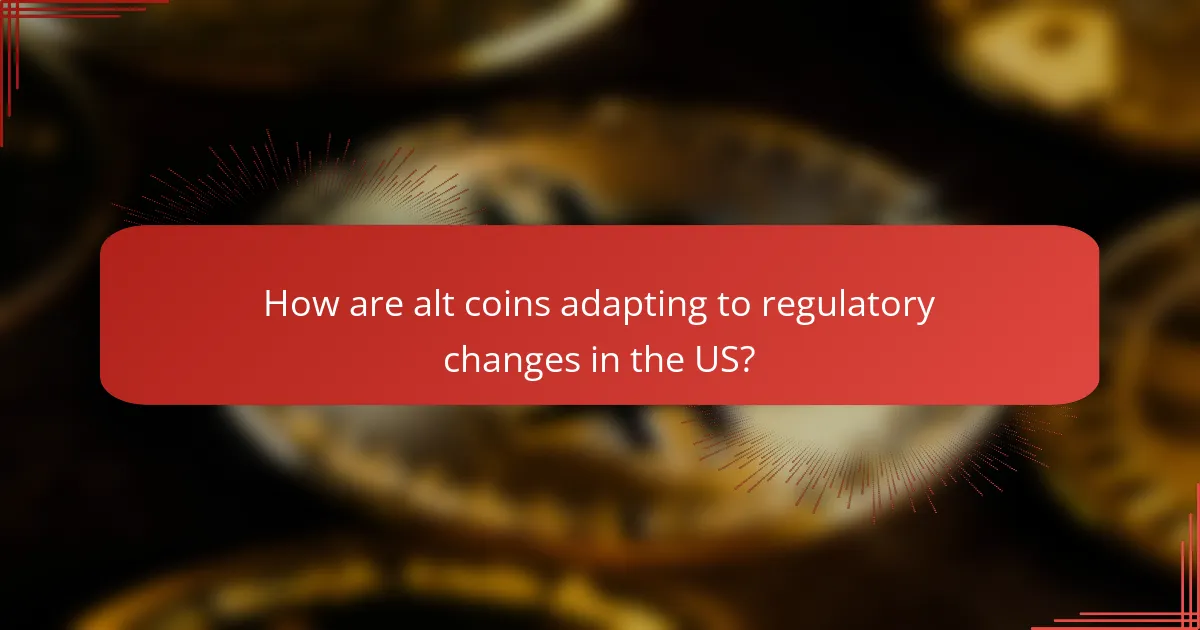
How are alt coins adapting to regulatory changes in the US?
Alt coins are adapting to regulatory changes in the US by enhancing compliance measures, developing platforms that align with regulations, and forming partnerships with financial institutions. These strategies help them navigate the evolving landscape while maintaining user trust and market relevance.
Increased compliance measures
Many alt coin projects are implementing stricter compliance measures to meet regulatory requirements. This includes Know Your Customer (KYC) protocols and Anti-Money Laundering (AML) practices, which help ensure that users are verified and transactions are monitored.
Projects that fail to comply may face significant penalties or be delisted from exchanges, making compliance a critical focus. Alt coins are increasingly investing in legal expertise to navigate the complex regulatory environment effectively.
Development of regulatory-friendly platforms
Alt coins are focusing on creating platforms that are designed to be compliant with existing regulations. This includes integrating features that facilitate reporting and transparency, which can help satisfy regulatory bodies.
Some alt coins are exploring decentralized finance (DeFi) models that still adhere to regulatory frameworks, allowing them to operate within legal boundaries while offering innovative financial services. This approach can attract users who prioritize security and compliance.
Partnerships with financial institutions
Forming partnerships with established financial institutions is a key strategy for alt coins to gain credibility and access to broader markets. These collaborations can provide the necessary infrastructure for compliance and enhance user trust.
For example, some alt coins are working with banks to facilitate fiat-to-crypto transactions, which can streamline the user experience and ensure adherence to financial regulations. Such partnerships can also lead to innovative products that bridge traditional finance and cryptocurrency.
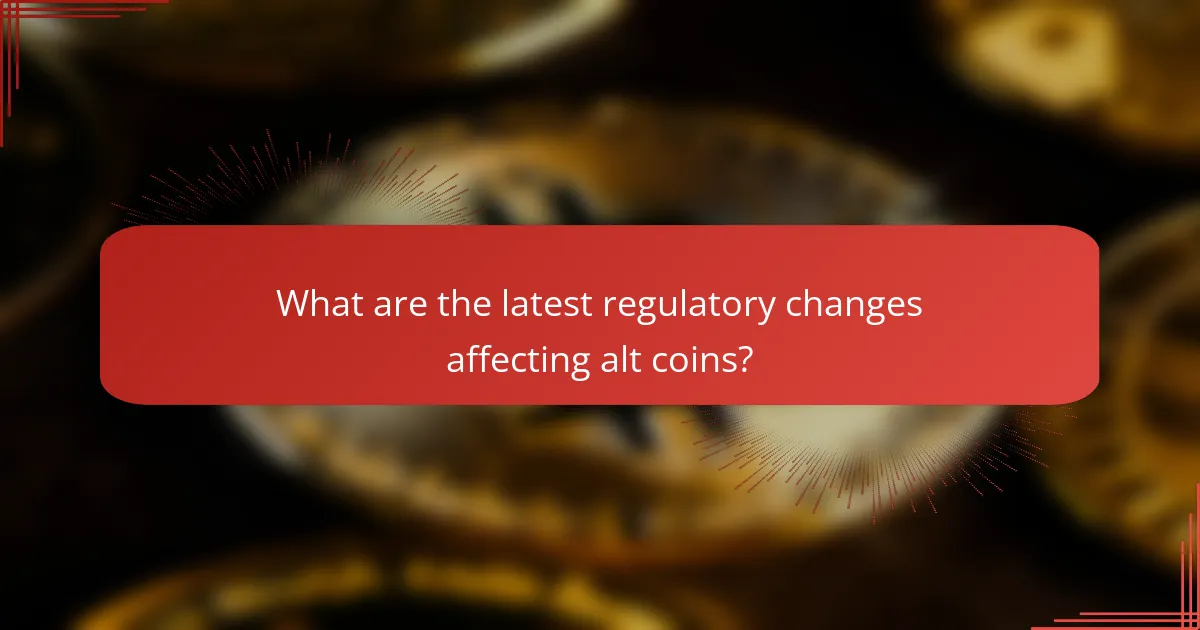
What are the latest regulatory changes affecting alt coins?
Recent regulatory changes are significantly impacting alt coins, with various jurisdictions tightening rules to enhance consumer protection and market integrity. Key developments include new guidelines from the SEC, state-level regulations in California, and the EU’s MiCA framework, all of which shape how alt coins are traded and managed.
SEC guidelines on digital assets
The SEC has introduced clearer guidelines for digital assets, focusing on whether a cryptocurrency qualifies as a security. This classification affects how alt coins are marketed and sold, requiring issuers to comply with securities laws if deemed securities.
Companies must ensure they register their offerings or find exemptions to avoid penalties. This has led many alt coin projects to reassess their compliance strategies, often opting for more transparent practices to align with regulatory expectations.
State-level regulations in California
California has implemented specific regulations for cryptocurrency businesses, including licensing requirements for exchanges and wallet providers. The California Department of Financial Protection and Innovation oversees these regulations, aiming to protect consumers from fraud and ensure operational transparency.
Businesses operating in California should be aware of the need for a BitLicense or similar permits, as non-compliance can result in hefty fines. This state-level scrutiny encourages alt coin projects to adopt best practices in security and consumer engagement.
Impact of the EU’s MiCA framework
The EU’s Markets in Crypto-Assets (MiCA) framework aims to create a comprehensive regulatory environment for cryptocurrencies, including alt coins. This legislation is designed to standardize rules across member states, promoting innovation while safeguarding investors.
Under MiCA, issuers of alt coins must provide detailed white papers and adhere to strict disclosure requirements. This regulatory clarity is expected to attract institutional investors, as it enhances trust in the market. Alt coin projects looking to operate in Europe should prepare for compliance with these new standards to remain competitive.
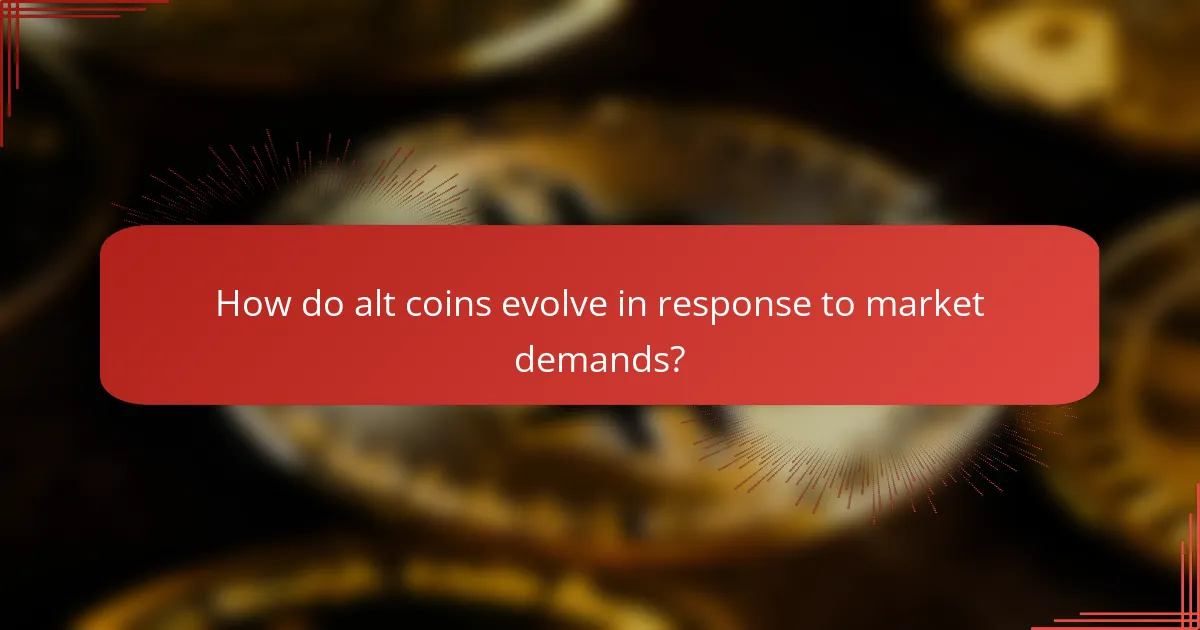
How do alt coins evolve in response to market demands?
Alt coins adapt to market demands by introducing innovative features and aligning with emerging trends. This evolution often involves enhancing functionality, integrating with popular platforms, and addressing user concerns such as sustainability.
Introduction of DeFi features
Decentralized Finance (DeFi) has transformed how alt coins operate, allowing them to offer services like lending, borrowing, and yield farming. By incorporating DeFi features, alt coins can attract users seeking more than just a store of value, enhancing their utility and market appeal.
For example, coins like Aave and Compound have successfully integrated DeFi protocols, enabling users to earn interest on their holdings. This shift not only increases user engagement but also drives demand for alt coins that support these functionalities.
Integration with NFT marketplaces
Many alt coins are now integrating with Non-Fungible Token (NFT) marketplaces to capitalize on the growing interest in digital collectibles. This integration allows alt coins to facilitate transactions and support the creation and trading of NFTs, broadening their use cases.
For instance, Ethereum-based alt coins like Flow have gained traction by providing platforms for NFT transactions, which has significantly boosted their visibility and market presence. This trend highlights the importance of adaptability in the evolving crypto landscape.
Focus on sustainability and energy efficiency
As environmental concerns rise, alt coins are increasingly prioritizing sustainability and energy efficiency. Coins that utilize proof-of-stake or other low-energy consensus mechanisms are becoming more appealing to environmentally conscious investors.
For example, Cardano and Solana have adopted energy-efficient protocols, which not only reduce their carbon footprint but also attract users who value sustainability. This focus on eco-friendliness can be a decisive factor for investors when choosing which alt coins to support.

What criteria should investors consider for alt coin selection?
Investors should consider several key criteria when selecting alt coins, including market capitalization, liquidity, technological innovation, and regulatory compliance. These factors can significantly impact the potential for growth and the associated risks of investing in alternative cryptocurrencies.
Market capitalization and liquidity
Market capitalization refers to the total value of a cryptocurrency, calculated by multiplying its current price by the total supply of coins. A higher market cap generally indicates a more established coin, which may offer greater stability and lower volatility. Liquidity, on the other hand, measures how easily a coin can be bought or sold without affecting its price.
Investors should look for alt coins with substantial market capitalization and high liquidity, as these factors can facilitate smoother transactions and reduce the risk of price manipulation. Coins with lower market caps may present higher potential returns but also come with increased risk due to limited trading volume.
Technological innovation and use cases
Technological innovation is crucial in distinguishing alt coins from one another. Investors should assess the underlying technology, such as blockchain efficiency, scalability, and security features. Coins that introduce unique solutions or improvements to existing technologies may have a competitive edge.
Additionally, evaluating the use cases of an alt coin can provide insights into its long-term viability. Coins that address real-world problems or offer practical applications, such as decentralized finance (DeFi) or non-fungible tokens (NFTs), are often more appealing to investors. Understanding the project’s roadmap and development team can also indicate its potential for growth.
Regulatory compliance status
Regulatory compliance is increasingly important for alt coins, as governments worldwide are establishing frameworks for cryptocurrency operations. Investors should research whether a coin complies with local regulations, which can affect its legitimacy and market acceptance. Non-compliance can lead to legal issues or restrictions that may hinder a coin’s growth.
Monitoring the regulatory landscape is essential, as changes can impact the value and usability of alt coins. Investors should prioritize coins that demonstrate transparency and proactive engagement with regulatory bodies, as these factors can enhance trust and stability in the market.
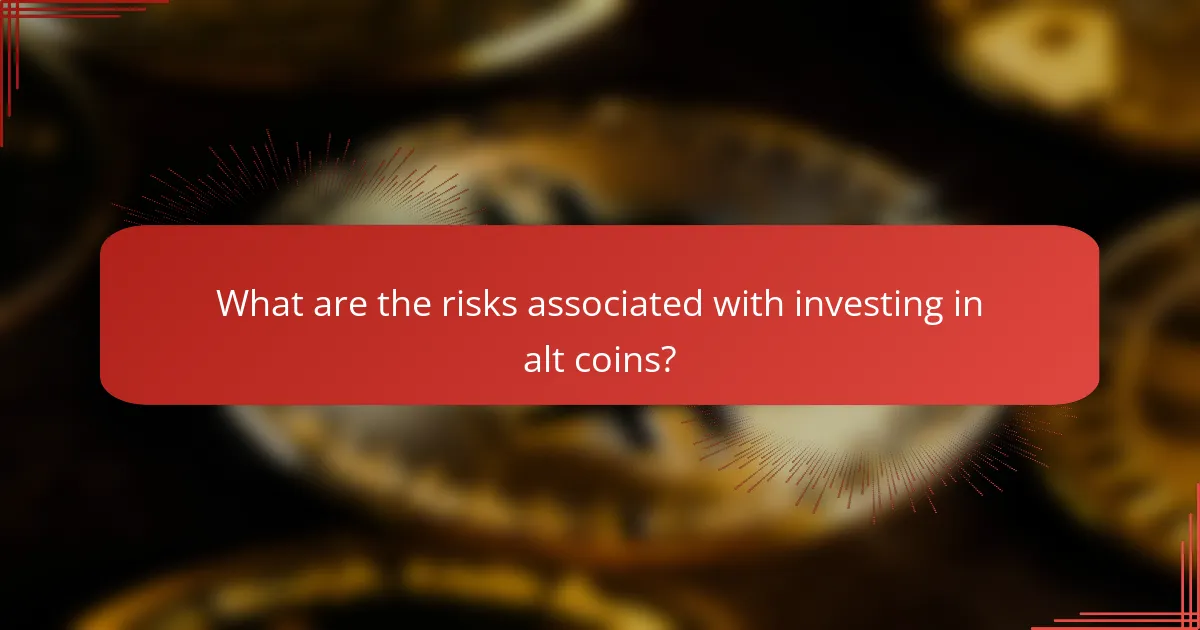
What are the risks associated with investing in alt coins?
Investing in alt coins carries several risks that can significantly impact returns. Key risks include market volatility, regulatory uncertainty, and security vulnerabilities, all of which require careful consideration before investing.
Market volatility and price manipulation
Alt coins are known for their extreme price volatility, which can result in rapid gains or losses. Prices can fluctuate dramatically within short periods, often influenced by market sentiment, news, or social media trends.
Additionally, some alt coins may be susceptible to price manipulation, where individuals or groups artificially inflate prices to profit from unsuspecting investors. This can occur through tactics like pump-and-dump schemes, making it crucial to conduct thorough research before investing.
Regulatory uncertainty and legal risks
The regulatory landscape for alt coins is constantly evolving, leading to uncertainty for investors. Different countries have varying regulations regarding cryptocurrencies, which can affect the legality and trading of specific alt coins.
Investors should stay informed about local regulations and potential changes that could impact their investments. For instance, in the European Union, new regulations may require compliance with strict anti-money laundering laws, which could affect certain alt coins.
Security vulnerabilities and scams
Security is a significant concern when investing in alt coins, as many projects may lack robust security measures. Vulnerabilities in smart contracts or wallets can lead to significant losses if exploited by hackers.
Moreover, the alt coin market is rife with scams, including fraudulent projects and phishing attacks. Investors should be cautious and conduct due diligence, ensuring they only invest in reputable projects with transparent teams and clear use cases.
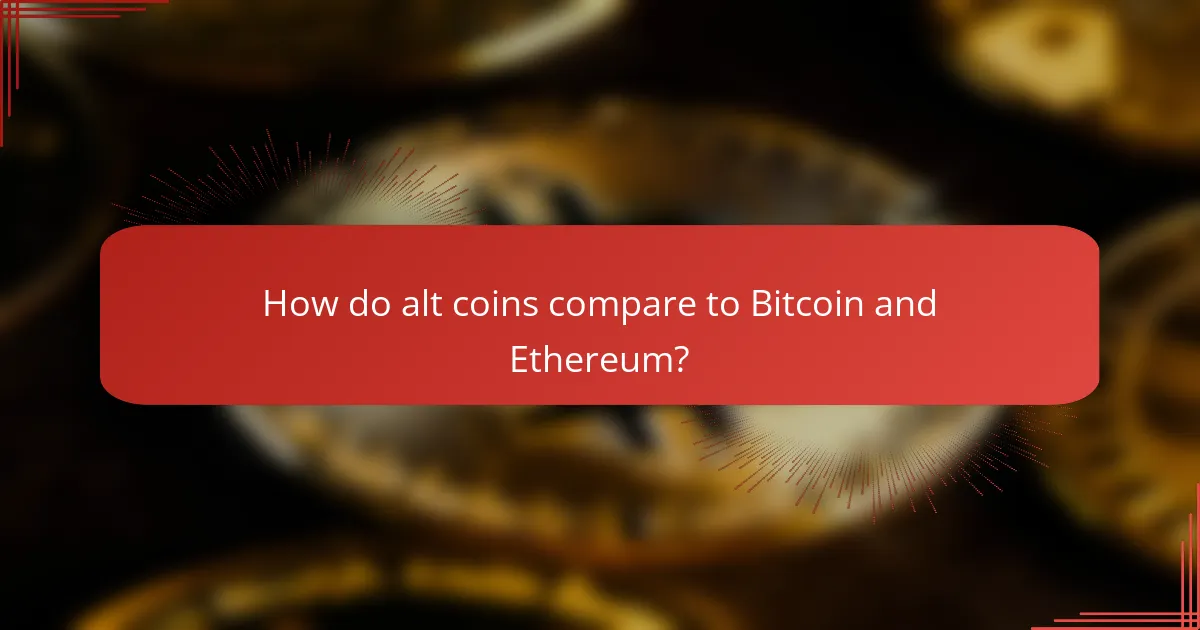
How do alt coins compare to Bitcoin and Ethereum?
Alt coins differ from Bitcoin and Ethereum primarily in their use cases, technology, and market performance. While Bitcoin is often seen as digital gold and Ethereum as a platform for decentralized applications, alt coins can serve various purposes, including privacy, smart contracts, and tokenization.
Market performance metrics
Market performance metrics for alt coins can vary significantly compared to Bitcoin and Ethereum. Alt coins often exhibit higher volatility, with price swings that can exceed those of the leading cryptocurrencies. For instance, while Bitcoin might experience a 5-10% fluctuation in a day, some alt coins can see changes of 20% or more.
Investors should consider market capitalization, trading volume, and liquidity when evaluating alt coins. A lower market cap can indicate higher risk but also potential for greater returns. It’s essential to analyze these metrics in conjunction with the overall market trends to make informed decisions.
Technological differences
Technologically, alt coins often introduce unique features that differentiate them from Bitcoin and Ethereum. For example, some alt coins focus on privacy enhancements, like Monero, which uses advanced cryptographic techniques to ensure transaction anonymity. Others, like Cardano, emphasize scalability and sustainability through innovative consensus mechanisms.
Moreover, many alt coins utilize different blockchain architectures, which can affect transaction speed and costs. For instance, Solana is known for its high throughput and low transaction fees, making it attractive for decentralized applications. Understanding these technological differences is crucial for investors looking to diversify their portfolios with alt coins.


